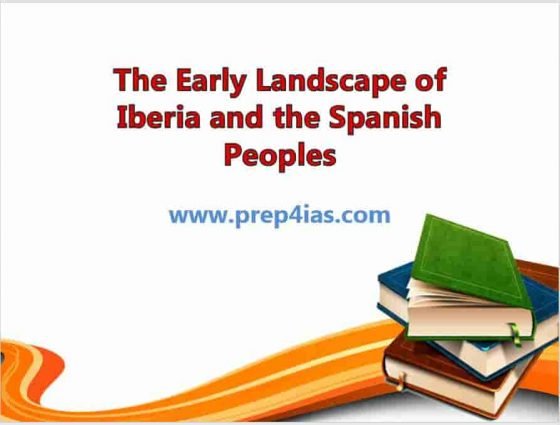The area that is Spain today covers an Atlantic Ocean and Mediterranean Sea shoreline. In a period of Spain’s early history, it was called the Iberian Peninsula. Its connections to the pre-Romans, the Greeks, Phoenicians, and Carthage during the Classical Antiquity period on the Iberian Peninsula where open frontiers existed. The Iberian Peninsula was annexed by many cultures from within the Mediterranean, making a rich mix of Carthaginians, Roman and Greek cultures.
Iberia also had connections to the British Isles as early inhabitants were established there well before the Roman occupation of Britain. The native peoples of Iberia were the Tartessos, a more ancient Iberian Peninsula civilization of Phoenician and Paleohispanic descent and traits, who were absorbed into the colonial Romans, Greeks and Carthaginian ethnic groups during occupation.

The Early Landscape of Iberia and the Spanish Peoples
Also Read: The Precolonial Americas: North and South American Civilizations
The Romans at one stage, from around 5 BCE had several provinces in Iberia, in line with the Western Roman Empires annexations in the Mediterranean. The land mass of the future Spain would make the Spanish peoples a large state and future neighbors with the smaller Kingdom of Portugal on the same peninsula.
The Roman Empire
The Iberian Peninsula was occupied by the pre-Romans (not later Roman Empire), Carthaginians, and Greeks in their turn during the Classic Antiquity period. The provinces of the peninsula from these mixed influences became a rich mix of peoples of the changing Iberian peninsula’s population.
An early Paleohispanic writing script was formed, influenced by the many language groups found in Iberia. The Romans called the entire peninsula Hispania. The name of Spain originates from the Roman Hispania.
Iberia gained much during the time of Roman Hispania, as the Roman Empires occupation was named. Roman rules of law, Spain’s present languages and religion were established during these years of stability.
The Germanic Gothic Invasion
The Magna Germanic tribes ventured into Iberia via the crossing of the Pyrenees mountains on numerous occasions during the 4 - 5th centuries CE, causing Roman infrastructure and rule to fade. The fall of the Roman Empire was not as catastrophic in Iberia/Spain as it was in Roman Britain, Gaul and Germania minor as the effect was in the classic Western societies of the early Middles Ages.
The Germanic Visigoths and Suebi and other Germanic groups, the Vandals, Alans and Lombards, created their own kingdoms in Iberia. The Vandals were in their Kingdom of Vandalusia (Andalusia). The Suebi kingdom in Gallaecia in the Northwest, the Visigothic kingdom in Toledo. Territories of the Byzantine empire were also in the Southeast.
It is important to note that the Visigothic Kingdom was the biggest of the Germanic Gothic occupation, their kingdom converted to Roman Catholicism. The period becoming known as the Middle Ages of Spain, the Germanic or Gothic Hispania kingdom lasted for 200 years.
The Islamic Invasion
The Islamic Ammayad (Umayyad) invasion and conquest of the Iberian Peninsula occurred in 711 ADE, which marked the introduction of Islam to Iberia. The Muslim forces swept many kingdoms before them in the Middle East and parts of the Mediterranean after this time. This would last for much of the early Middle Ages in Europe. The Islamic invasion basically follows as a historiographic of the Muslim invasions of the Middle East in the 8th Century and the Iberian Islamic state of occupation during this period, as well as the later Christian religious Crusades of 1051 in and around Jerusalem to protect Christianity from the Seljuk Turks and other Islamic kingdoms.
The Islamic occupation became Al-Andalus and covered many parts of Iberia except the Northern ‘bulge’ of the region which remained Christian, the kingdom of Asturias. This period of expansion became the Islamic Golden Age.
This is the time before the beginning of the greater Middle Ages also called the High Tide of the period in Spain, where Christianity in the Iberian Peninsula started to spread in resistance to and control of Islam over all the peninsula.
Muslim Al-Andalus would not be easily beaten during their height of power, so the wars went on for many years into the Middle Ages. These conflicts of emancipation for the Iberian Peninsula became known as the Reconquista, describing a 781-year period between the 771 Ammayad (Umayyad) Islamic annexure of Iberia to the later Middle Ages in 1492, when the Reconquista also moved South forming the Kingdoms of Castile and Aragon, in Central and Eastern Iberia respectively. Castile and Aragon continued as separate states for centuries before Spanish unification.
The history of the Castile and Aragon kingdoms basically intertwined becoming two polities which were generally equivalent to each other. The Reconquista advanced Southwest during the conflict, the Southwest becoming the Kingdom of Portugal.
Christian faith in Spain was instituted as Roman Catholic, the influence of the Holy Roman Empire into the Middle Ages can be attributed to this and the long struggle against the Islamic invasions and occupation.
Conclusion
The history of early Spain was influenced by changing empires in Europe. Long struggles ensued from many aspects. Religion, self-identity and foreign incursion all played their parts in creating a Spanish sovereignty through history.
